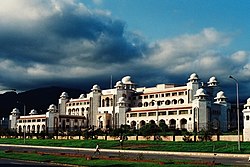Prime Minister Office Wing
The Prime Minister's office wing, situated within the Prime Minister of Pakistan House, comprises the Prime Minister's office, which includes a designated meeting area for the PM to hold discussions with guests and ministers. [1] The wing features galleries displaying portraits of Liaquat Ali Khan, Pakistan's first Prime Minister, and Muhammad Ali Jinnah, the founding father of Pakistan. [1] The wing also contains the office of the Principal Secretary to the Prime Minister of Pakistan, a waiting room for press meetings, a press media hall, conference rooms, guest rooms, banquet halls, and a cabinet meeting room. [1]
Nawaz Sharif was the first to occupy the Prime Minister's office in the early 1990s, followed by Benazir Bhutto. [1] After the removal of Nawaz Sharif's government by Pervaiz Musharraf, the office was used as Musharraf's camp house, although he primarily resided at the GHQ. [1] The office was subsequently used by Zafarullah Khan Jamali, Shaukat Aziz, Shujaat Hussain, Yousuf Raza Gillani, Raja Pervaiz Ashraf, and Nawaz Sharif. [1] Malik Meraj Khalid and Shahid Khaqan Abbasi, both former Prime Ministers, chose not to reside in the PM House and used only the PM office during their tenures. [1]
Banquet for the State Guests
The Prime Minister of Pakistan House includes a banquet hall to host state guests. [1] The hall is spacious and can accommodate a large number of people, including media representatives. [1]
Cabinet Meeting Room
The Cabinet Meeting Room was constructed during the last tenure of former Prime Minister Nawaz Sharif to hold cabinet meetings. [1] The room features gold-plated elements and modern furnishings. [1] It serves as a dedicated space for the prime minister and cabinet members to convene and discuss matters of national importance. [1]
Prime Minister Conference Hall
The conference hall was specifically designed to host large gatherings addressed by the prime minister. [1] The hall is spacious and furnished with chandeliers and furniture. [1] It has been the venue for multiple meetings of the National Security Cabinet Council, attended by the Chief of Army Staff (COAS), the Director-General of Inter-Services Intelligence (DG ISI), and other high-ranking military officials. [1]

